Dog Communication With People
Dog Communication With Humans.
From Your Dog Trainer Andrew Ledford 714-827-4058
Is dog communication with humans possible?
Learn to communicate with your dog in a way the dog was created to understand.
Dogs communicate with:
- Vocalizations
- Body language
- Touch
- Scent
Dog communication and behavior displays during play at Huntington Beach Dog Park
Dog communication and behavior displays during play at Huntington Beach Dog Park
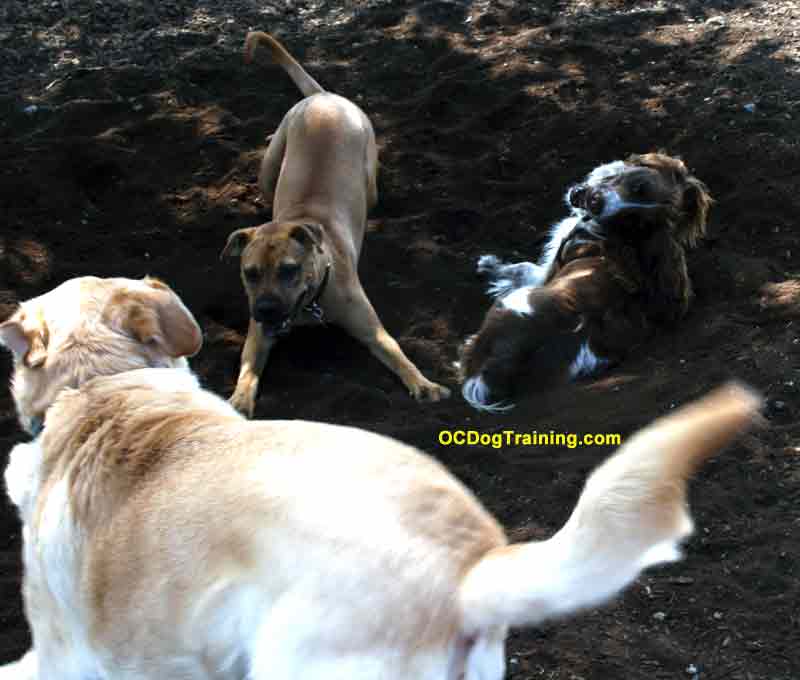
Using clear communication is how we let our dogs know what we expect from them. We need to learn how to effectively communicate that we’re happy, or if we disapprove of the dog’s behavior.
When we pay attention and study our dog’s behavior, we can learn how to communicate in ways the dog instinctively understands. One way not to convey this message is with a constant barrage of verbal chatter.
Use your dog’s natural instinctive behavior to communicate = You are who they should follow.
It doesn’t matter what training style you prefer, what we are interested in is, does the dog follow your lead? Your dog could follow you because of the bond you have with your dog. However, In some training styles it could only be that you have a treat. Don’t worry, in most food reinforcement training programs it’s both. We can also strengthen the bond of trust and love between human and dog by using ritualized behavior as a form of communication.
Dog communication and Verbal Behavior
Many people feel their dogs can understand human language. That would be English for most of the people I work with here in the States. These people think they can explain a problem to the dog like it was a young child. While your dog may focus on you attentively, it’s unlikely to understand that you are giving it a cause and effect warning. I disagree with and discourage people from using the explain and coax model of pedagogy with their pets.
It is accepted by scientists and researchers that dogs do not possess the ability for complex abstract thought that is necessary to understand language. However, they do understand parts of language like tone. They can also respond to some rather complex patterns of which language can be a big part. There can also be complex communication patterns that involve both verbal behavior and nonverbal behavior. Many dogs also respond to additional variables including environmental factors that go unnoticed by most people.
While studying Chinese I think I may have gotten a glimpse of how a dog might interpret words. In the beginning if I really listened to a conversation, I could understand very few words. As I became more conditioned, I could pick out more words. I could even understand some when I was not paying attention. However, I did not really know what was being said. I only knew what some of the sounds represented or stood for. I only knew sounds that I was conditioned (trained) to respond to. I did not know the context of how the words were used.
The first step to good communication with your dog is: don’t talk too much. Your canine friends do not spend hours in long verbal conversations with each other.
These are the dog training commands and phrases I use in my training programs.
There are always exceptions to the rules. When I was a youngster and worked extensively with police, protection, and guard dogs. I would often talk with and sing to the dogs I transported and handled. I found that this constant barrage of verbal behavior helped make the dogs more manageable. We need to take into account that I was working with aggressive dogs in a controlled environment. Much of our vocal behavior is really ritualized aggression. Interestingly, it is often ritualized aggression that builds the bonds that unite individuals.
Dog communicating with vocalization combined with body language that can be seen as positioning and movement.
This photo was taken at a location in Long Beach, CA
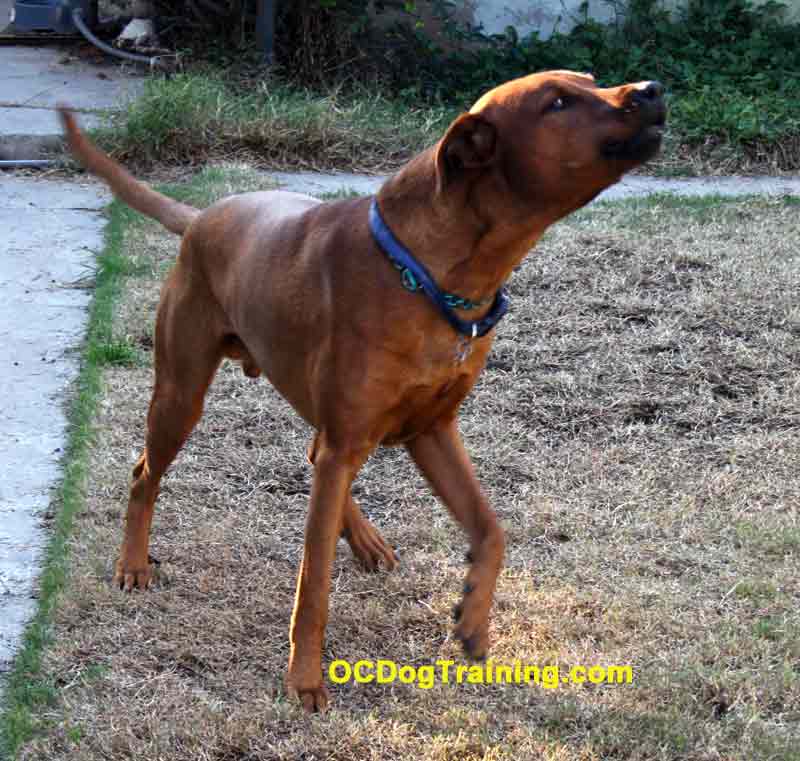
Dog communicating with vocalization combined with body language that can be seen as positioning and movement. This photo was taken at a location in Long Beach, CA
Dog communicating with vocalization combined with body language that can be seen as positioning and movement. This photo was taken at a location in Long Beach, CA
Tone inflection influences how a dog responds to its owner and the people in its life. To us humans it may appear that our pets don’t have many different verbal patterns (howling, whining, barking, growling, snorting, crying). However, when we closely listen to many of the different canine vocalizations we discover a wide variety of meanings. These verbally communicated meanings are usually indicated by intensity, duration, tempo, and notably, tone inflection.
Barking is perhaps the most common form of vocal communication people associate with dogs. How a dog barks is a language of its own. There are many types of barking from playful barks to threatening barks. Within categories of barking there are subtle meanings. Threat barking can tell others about the dog’s level of aggression, fear, and confidence. The kind of bark is a clue as to the likelihood of the dog actually biting.
When communicating with your pet use tone inflection that is appropriate to the message you’re trying to convey.
Avoid excessive verbalization with your dog, otherwise your best friend may think its human has a whining problem, or maybe it’s a growling problem. Sometimes when a dog tries to adapt to their human’s problem they develop some problems of their own. Ignoring your dog is better than excessive verbalization.
Dog communication and Body Language
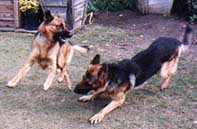
Dogs are almost always communicating with each other and with their humans. The majority of this communication is through body language. Our problem is that we only understand some of the vocabulary.
One of the best ways to start learning how to understand what your dog is trying to communicate to you is to really watch the dog. A good obedience training drill for dog watching is the long Sit Stay. You will learn a great deal about your dog from the long Sit Stay. One useful skill you will learn is how to tell when your dog is thinking about getting up. You will also learn what body language your dog uses to communicate mild social stress. If you pay close attention you’ll begin to understand what your dog is trying to tell you.
How your dog communicates is very evident when you and your dog are stressing each other socially. When you train your Canine Einstein , you are teaching your pet how to respond to social stress in an acceptable manner. It’s dog training that gives most people the opportunity to really begin the process of decoding canine communication.
Once you understand your canine companion’s body language you can start to communicate with your best friend in a language they understand.
We can supplement the dog’s natural language with conditioning (training), that includes verbal and body cues. You are teaching these cues even if you don’t intend to. It’s a good idea to make sure you’re teaching useful behaviors and cues that will enhance your life and the life of your dog.
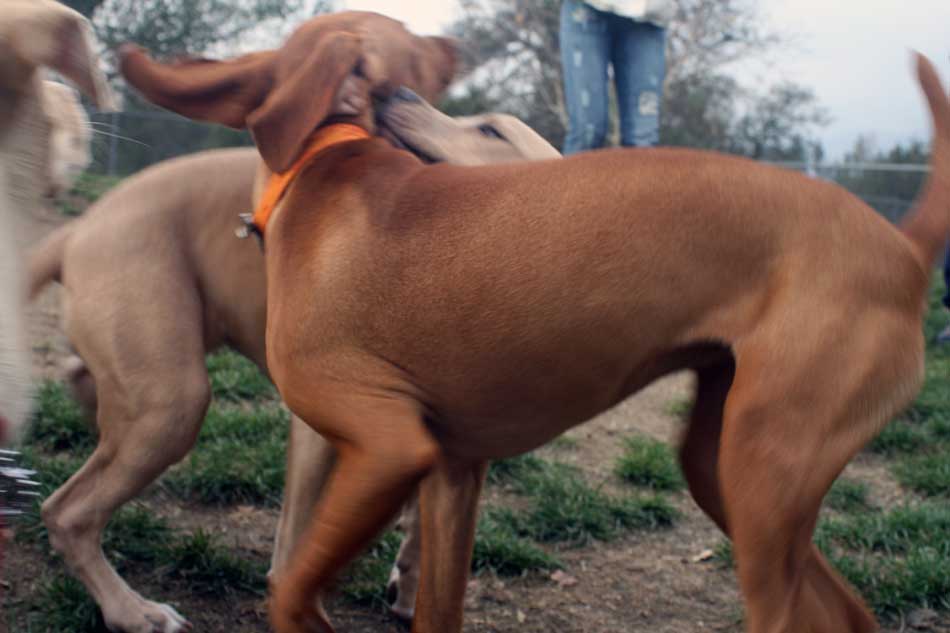
Dog Communication Takes Place In Play And Other Forms Of Ritualized Aggression – Pictured Is A Vizsla and a Labrador Playing at a dog park
Dog Communication Takes Place In Play And Other Forms Of Ritualized Aggression – Pictured Is A Vizsla and a Labrador Playing at a dog park
I have known people who train elephants to camels and they all acknowledge there are certain types of positioning that all mammals respond to. Mammals respond to and communicate through positioning in more or less established and predictable ways.
A big part of understanding and communicating with your dog is understanding where your pet is physically in relation to other living beings. Be aware of your pet’s spatial relationship to significant environmental points of reference. I talk more about this in my book Best Friends Learning Together. Basically there are 8 positions that one should be aware of.
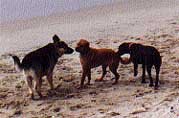
Get more information on my dog training classes
or
Call Andrew Ledford at 714-827-4058 today to get more information about training your dog.
